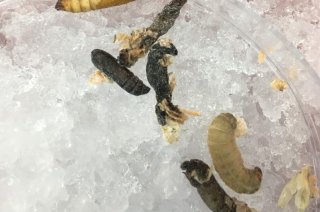
PhD project
Project 4 Microsporidia infection and virulence at varying population densities (UK)
Little is known about what future risk Microsporidia pose to insects reared for food and feed. However, past experiences with intensive invertebrate rearing indicate that these parasites, whilst generally benign, can rapidly sweep through populations causing extensive damage.
My work aims to assess the diversity of microsporidia that may affect reared insect and to study the effect of insect host population densities on the transmission and virulence of these parasites. This project takes place at the University of Exeter and the University of Copenhagen.
My research project entitled “Microsporidia infection and virulence at varying population densities” is well fitted in this WP as I will study interaction between microsporidia and their hosts under certain stressors (i.e. host density, and potentially co-infection).
Microsporidia are a group of obligate intracellular parasites that infect a huge range of different animals. They often cause benign infections and go unnoticed. However, when hosts become immunocompromised or stressed these pathogens can cause severe disease, called microsporidiosis. This has been the case with microsporidia infections in honeybees that are affected by other stressors such as pesticides and other microbes, and in shrimp farms where animal are reared in high density, high stress conditions.
Since the risk of microsporidia to the rearing industry is not fully assessed, I will start to carry out a broad survey of parasites in samples from pet shops and other industry partners. The focus will be on the insect models Galleria mellonella and Tribolium confusum, but I will expand the investigation to other key insect species such as Tenbrio molitor, Blaptica dubia, Shistocerca gregaria, Zophobas Morio, Locusta migratoria, Acheta domesticus and Hermetia illucens. In the survey, I will also look for other eukaryotic parasites such as gregarines, nematodes, plasmodium and amoeba species that also may represent future challenges to the insect rearing industry.
Two significant strategies for the detection of parasites will be used: (1) lab techniques involving microscopy observation and PCR of insects obtained from commercial rearing facilities, (2) screening of the NCBI Sequence Read Archives (SRA) database, using bioinformatics tools, where a lot of insect genomic and transcriptomic data are available but not analyzed for presence of microsporidia, which may have been incidentally sequenced.
Once we identify our insect hosts – parasites models, we will set up healthy and infected colonies in order to start bioassays. Before all bioassays, the pathogenicity of the parasites within our insect models will be confirmed with the Koch's postulates and the kinetics of the infection determined under standard rearing conditions.
These bioassays, with experimental infections, will allow us to test the hypothesis that high host population densities can favor both increased transmission and virulence of pathogens. The transmission is measured as the rate at which susceptible hosts become infected individuals. The virulence of a parasite is defined as the host’s loss of fitness (longevity and fecundity). In addition, I will further look into the relationship between the host density and the host immunity under a parasite infection.
The aim of this project is to produce empirical data on microsporidiosis, and other diseases potentially triggered by other eukaryotic parasites, with changing insect density. I am convinced that this research project will help insect farmers and industries to better understand the risk of microsporidia under mass rearing condition, which is frequently overlooked, but can result in the collapse of an entire insect colony. This project will also bring new insights into other understudied eukaryotic parasites within reared insect species.
